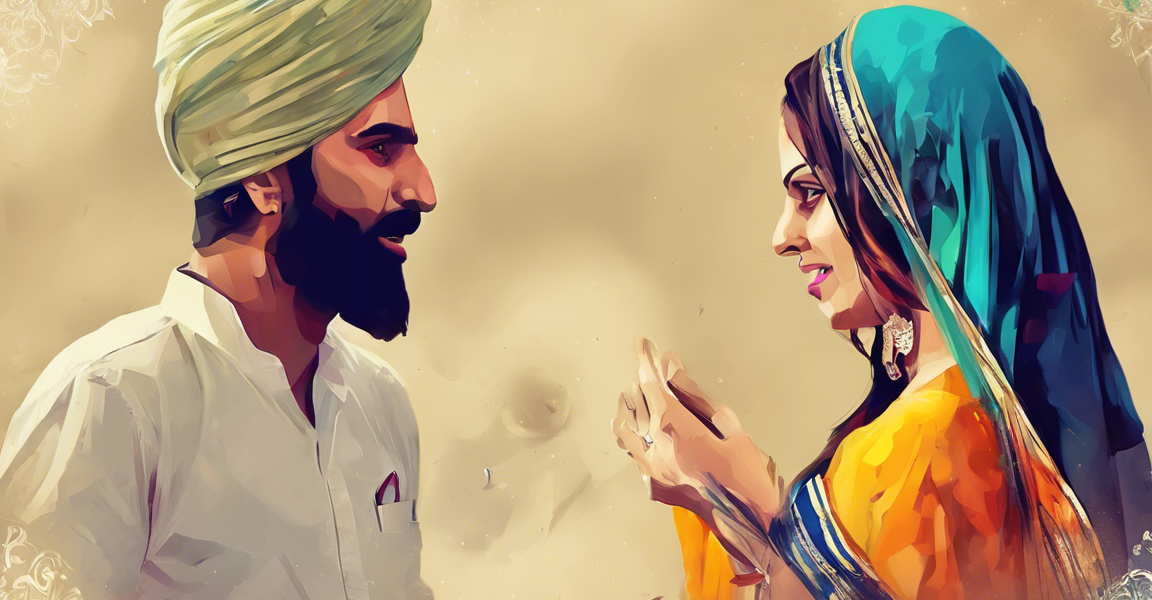Introduction
Punjabi Shayari is a form of poetry that finds its roots in the rich cultural heritage of Punjab. Often expressed in the Punjabi language, Shayari is a beautiful and emotional way of conveying feelings, thoughts, and emotions through carefully crafted verses. The word “Shayari” itself is derived from the Arabic word “Shair,” which means a poet or a poetess. Punjabi Shayari has evolved over the years to encompass a wide range of themes, styles, and emotions, making it a vibrant and expressive art form that resonates with people from all walks of life.
The History of Punjabi Shayari
Punjabi Shayari traces its origins back to the 16th century with the advent of Sufi poets like Baba Farid and Bulleh Shah. These poets used the power of words to spread messages of love, peace, and unity among the masses. Over the centuries, Punjabi Shayari has been influenced by various literary movements and poetic traditions, including the Bhakti movement, the Romantic era, and modernist poetry. Today, Punjabi Shayari continues to captivate audiences with its lyrical beauty and profound themes.
Themes in Punjabi Shayari
Punjabi Shayari covers a wide array of themes, reflecting the diverse experiences and emotions of the Punjabi people. Some of the common themes explored in Punjabi Shayari include:
-
Love: Love is perhaps the most popular theme in Punjabi Shayari, with poets beautifully expressing the joys and sorrows of romance through their verses. Whether celebrating the bliss of new love or lamenting the pain of heartbreak, Punjabi Shayari captures the essence of love in all its forms.
-
Nature: Many Punjabi poets draw inspiration from the beauty of nature, weaving vivid descriptions of the natural world into their poetry. Through their verses, they explore the changing seasons, the splendor of the countryside, and the eternal beauty of the earth.
-
Spirituality: Punjabi Shayari also delves into spiritual themes, with poets reflecting on the divine, the soul, and the mysteries of existence. These poems often offer insights into the nature of spirituality and the quest for enlightenment.
-
Social Issues: Some Punjabi poets use Shayari as a platform to address social injustices, political upheavals, and cultural issues. Through their powerful and moving verses, they shed light on important societal concerns and advocate for change.
Styles of Punjabi Shayari
Punjabi Shayari encompasses a variety of poetic styles and forms, each with its own unique characteristics. Some of the popular styles of Punjabi Shayari include:
-
Ghazal: The Ghazal is a traditional form of poetry characterized by its intricate rhyme scheme and lyrical couplets. Punjabi Ghazals often explore themes of love, longing, and separation, creating a melodious and evocative mood.
-
Kafi: The Kafi is a form of Punjabi poetry that originated from the Sufi tradition. Kafis are often written in simple and direct language, making them accessible to a wide audience. These poems typically focus on themes of devotion, spirituality, and mysticism.
-
Dohe: The Dohe is a style of Punjabi Shayari that consists of two-line verses packed with wisdom and moral teachings. Dohe are concise yet profound, offering insights into human nature and life’s complexities.
Prominent Punjabi Shayars
Over the years, Punjab has been home to many talented poets who have left an indelible mark on the world of Shayari. Some of the most renowned Punjabi Shayars include:
-
Bulleh Shah: A Sufi poet and mystic, Bulleh Shah’s verses are celebrated for their spiritual depth and universal appeal. His poetry continues to inspire generations with its message of love and unity.
-
Amrita Pritam: An iconic figure in Punjabi literature, Amrita Pritam is known for her powerful and feminist poetry. Her verses explore themes of love, longing, and the female experience with honesty and courage.
-
Shiv Kumar Batalvi: Often referred to as the “rebel poet,” Shiv Kumar Batalvi’s poetry reflects the angst and turmoil of his tumultuous life. His emotional and poignant verses resonate with audiences across generations.
FAQs (Frequently Asked Questions)
- What is the significance of Punjabi Shayari in modern times?
-
Punjabi Shayari continues to be a vital form of artistic expression, connecting people through the beauty of words and emotions. It serves as a cultural touchstone and a means of preserving Punjab’s rich literary heritage.
-
How can one appreciate and understand Punjabi Shayari better?
-
To fully immerse oneself in Punjabi Shayari, it is helpful to learn the language and familiarize oneself with the cultural and historical contexts that have shaped this poetic tradition.
-
Are there any contemporary Punjabi poets making an impact with their Shayari?
-
Yes, there are several emerging poets who are gaining recognition for their innovative and thought-provoking Shayari. Their work reflects the changing dynamics of Punjabi society and offers fresh perspectives on traditional themes.
-
What role does Punjabi Shayari play in preserving the Punjabi language and heritage?
-
Punjabi Shayari plays a crucial role in safeguarding the Punjabi language and culture by celebrating linguistic diversity, promoting literary excellence, and fostering a sense of pride and identity among Punjabi speakers.
-
Can Punjabi Shayari be enjoyed by non-Punjabi speakers as well?
- Absolutely! The beauty of Punjabi Shayari transcends linguistic barriers, captivating audiences with its universal themes of love, nature, spirituality, and social issues. English translations and interpretations can also help non-Punjabi speakers appreciate the nuances of Punjabi Shayari.
In conclusion, Punjabi Shayari stands as a vibrant and timeless art form that continues to enchant poetry lovers with its lyrical beauty, emotional depth, and cultural richness. By exploring the themes, styles, and prominent poets of Punjabi Shayari, one can gain a deeper appreciation for this captivating poetic tradition that celebrates the spirit of Punjab.

